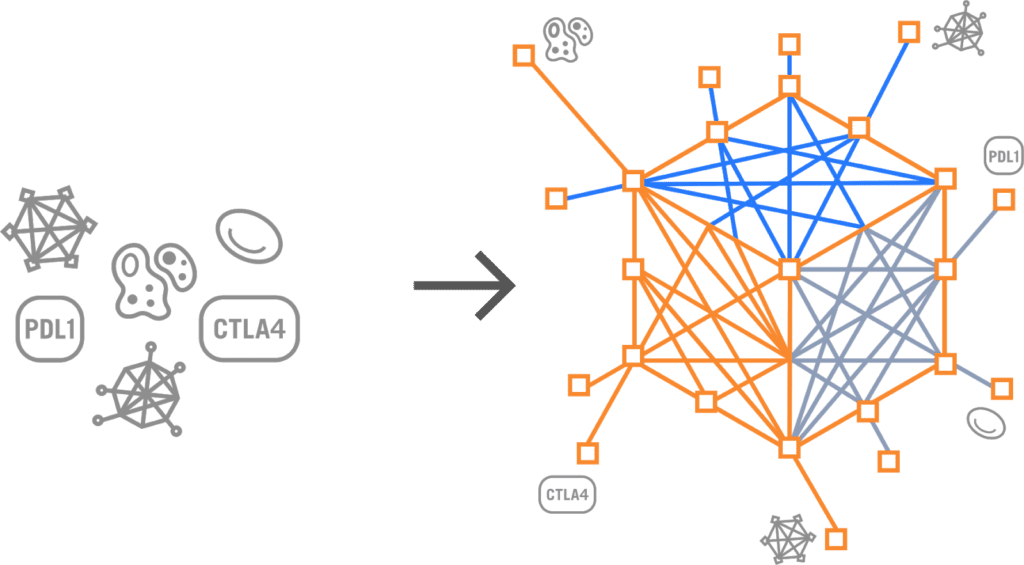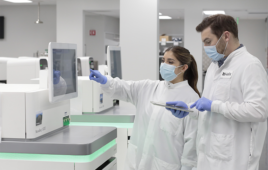
Image courtesy of Wikipedia
What do cupcakes have to do with oncology, and more specifically, predictive diagnostics?
Before I explain, I’ll provide some context. I recently came across an image that illustrated the difference between how Doppler radar detects conditions for a Tornado Watch versus a Tornado Warning using cupcakes.1 One side of the graphic shows each of the ingredients measured in individual containers. This visual represents when you have everything you need to make a cupcake; in weather terms, the conditions are favorable for a cupcake. A cupcake watch could be declared, but no fully-baked, devourable cupcake is visible yet. On the other side of the image, once the ingredients are assembled and baked, it’s much clearer that we have an actual cupcake on our hands and, therefore, a warning would be in place. For meteorologists, this is when Doppler radar has detected a full tornado, complete with rotation.
-

(Photo Credit: Brad Panovich, Meteorologist)1
Transitioning from biomarker watch to a biomarker warning
Several technologies aim to characterize a patient’s molecular profile for clinical decision-making. Examples include DNA panels that measure mutations or tumor mutational burden, targeted RNA sequencing looking at gene fusions or single-gene expression levels, and protein technologies, including immunohistochemistry (IHC), to look at protein levels. However, most often, we’re looking at these individual analytes in the same way as the ingredients in a cupcake. We can detect them with high accuracy and can even compare them side-by-side. We have all of the components needed for a powerful biomarker, a “biomarker watch,” if you will. Yet, most of these individual analytes are not powerful enough on their own. Routinely, entire clinical trials and individual patients’ treatment plans fail because using single-analyte technologies did not provide sufficient information to predict tumor response to therapy. We need our Doppler radar to move beyond individual analytes and use a multidimensional approach. This allows us to move from a biomarker watch to a biomarker warning.
Let’s consider the specific example of immune checkpoint inhibitors (ICIs). ICIs represent a powerful class of therapies changing the outlook for cancer patients. It has provided a new, powerful tool for clinicians to deploy in over 16 different cancer types and counting.2 Nonetheless, this class of therapies is not a one-size-fits-all solution. In fact, understanding a patient’s immune profile, or how their body’s immune system responds to the disease, is an integral part of predicting how successful this therapy will be. Because many of these therapies target specific pathways in the immune system (think anti-PD-1 monoclonal antibodies), the industry-first focused on measuring immune signals related to the drug’s mechanism of action. Currently, the on-label diagnostic and most prevalent tool for prescribing immune checkpoint inhibitors is PD-L1 IHC. But, this represents only one facet of immune response or one ingredient in our cupcake. Just because you identify and measure an egg, it doesn’t mean for certain a cupcake is in the making. Clinicians, working groups and guidelines committees routinely cite the limitations of PD-L1 and similar single-analyte technologies.3 In fact, the European Society for Medical Oncology states, “PD-L1 IHC positivity is an imperfect biomarker of response and currently not suitable as a definite biomarker for selection for therapy with PD-1/PD-L1 inhibitors. It is likely that a more complex, multicomponent predictive biomarker system will be required to refine appropriate patient selection for PD-1/PD-L1 blockade.”4 Clearly, there is a need for a technology that combines these ingredients (biological signals) to make a recognizable cupcake, in the form of a biomarker for more confident clinical decision-making.
A new class of diagnostics
This unmet need has led to the birth of a new class of diagnostics, built using multidimensional biomarkers. These biomarkers and downstream diagnostics are made possible due to the new field of predictive immune modeling. In this approach, solid tumor specimens from a well-defined and well-annotated clinical cohort that includes responders and non-responders to a therapy class are analyzed. In this tumor tissue, multiple immune signals are measured with high accuracy using RNA data and RNA models.5 As shown below, these signals are then combined using machine learning to generate a multidimensional model with predictive power-optimized to characterize tumor response. The biological signals, or analytes, include expression levels of co-inhibitory, co-stimulatory, and immune escape genes, as well as the composition and state of immune cells. When these signals are married together, we have a much clearer picture of the biological response happening at the solid tumor site. As described earlier, we have the biomarker warning. We can more clearly see the cupcake.

Individual immune signals, including co-inhibitory, co-stimulatory, and immune escape gene expression, are combined with immune cell composition to build a powerful multidimensional biomarker with enhanced predictive power.
While this analogy is somewhat lighthearted, the implications of this represent a modal shift in how we build diagnostics. Moving to a holistic, multidimensional view is a necessary and substantial change. Predictive immune modeling aims to provide a clinician with the most comprehensive view of a patient’s immune profile. When a clinician can only see a few of the signals (or ingredients), they’re left guessing. Using our baking example: when we only measure eggs, it’s unclear whether we’re baking a cupcake or a crème brûlée. Will the patient respond or have an adverse event to the therapy? Using predictive diagnostics built on multidimensional biomarkers moves us from biomarker watch to biomarker warning. In effect, these diagnostics are the Doppler radar needed to empower clinicians with all the ingredients they need to make the most confident and successful treatment decisions for their patients.

Jarret Glasscock
Jarret Glasscock, Ph.D., is the co-founder and CEO of Cofactor Genomics. After contributing to the Human Genome Project at Washington University in St. Louis, he founded Cofactor Genomics to leverage the power of RNA to diagnose disease.
Jarret’s background in genomics and his passion for precision medicine have enabled Cofactor to champion the creation of a new category of diagnostics, built on RNA models, improving cancer treatment.
References
- Watching Cupcakes… Watch vs. Warning – What’s The Difference? https://www.alabamawx.com/?p=181978 (Accessed January 28, 2021).
- Haslam A, Prasad V. Estimation of the Percentage of US Patients With Cancer Who Are Eligible for and Respond to Checkpoint Inhibitor Immunotherapy Drugs. JAMA Netw Open. 2019;2(5):e192535. https://doi:10.1001/jamanetworkopen.2019.2535
- Davis, A.A., Patel, V.G. The role of PD-L1 expression as a predictive biomarker: an analysis of all US Food and Drug Administration (FDA) approvals of immune checkpoint inhibitors. J. Immunotherapy Cancer 7, 278 (2019). https://doi.org/10.1186/s40425-019-0768-9.
- PD-L1 in Cancer: ESMO Biomarker Factsheet. https://oncologypro.esmo.org/Education-Library/Factsheets-on-Biomarkers/PD-L1-in-Cancer (Accessed January 28, 2021).
- Ian Schillebeeckx, Jon R. Armstrong, Jason T. Forys, Jeffrey Hiken, Jon Earls, Kevin C. Flanagan, Tiange Cui, Jarret I. Glasscock, David N. Messina, Eric J. Duncavage. Analytical Performance of an Immunoprofiling Assay Based on RNA Models, The Journal of Molecular Diagnostics, Volume 22, Issue 4, 2020, https://doi.org/10.1016/j.jmoldx.2020.01.009.
- Adkins D, Ley J, LaFranzo N, Hike J, Schillebeeckx I, Oppelt P, Palka K, LaFleur B. A Multidimensional Gene Expression Model that Accurately Predicts Tumor Response to Pembrolizumab or Nivolumab. International Journal of Radiation Oncology • Biology • Physics 106 (5), 1132-1133. DOI:https://doi.org/10.1016/j.ijrobp.2019.11.362
Filed Under: Genomics/Proteomics, Oncology





Tell Us What You Think!
You must be logged in to post a comment.